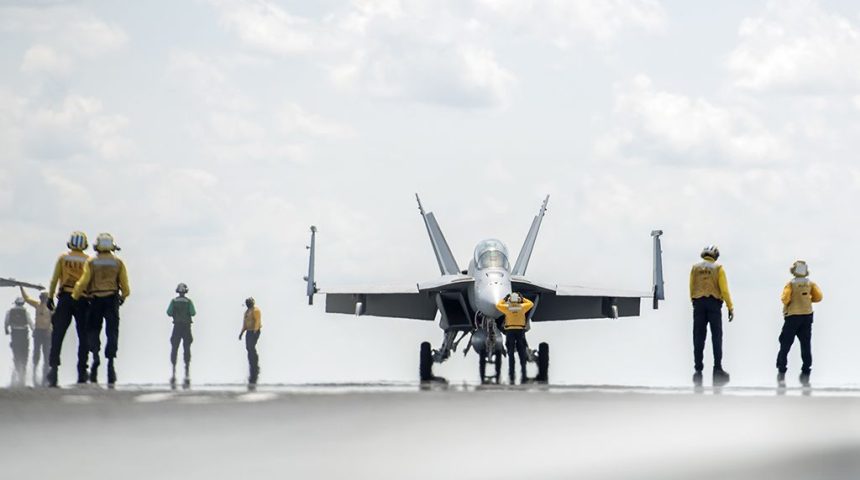A U.S. Navy Super Hornet blew off deck due to very bad weather.
A Super Hornet belonging to Carrier Air Wing 1 aboard USS Truman sailing in the Mediterranean Sea, blew off the flight deck of the aircraft carrier last week, the U.S. Navy said in a statement released on Sunday July 10, 2022.
The mishap is not related to the aircraft going overboard and occurred as the U.S. flattop was conducting a replenishment-at-sea, which was safely terminated through established procedures when it was hit by “an unexpected brief period of intense winds and heavy rains Friday morning” Stars and Stripes reported. No one was aboard the F/A-18E or F (the exact variant has not been disclosed). One sailor was injured due to the heavy weather but in stable condition and anticipated to make a full recovery, U.S. 6th Fleet said.
The incident is at least bizarre: while aircraft can go overboard during routine flight operations at sea, they shouldn’t be blown off the deck by weather. In fact, when rough seas or heavy weather is anticipated, aircraft and anything else that could potentially move, like tractors, carts, etc, are chained down when they are not used, so that they don’t fall from the flight deck. In the past, some aircraft have also been blown off the deck by the jet blast of other aircraft (for this reason carriers are equipped with JBDs – Jet Blast Deflectors – normally raised behind the catapult so that the exhaust from a departing jet does not hit and endanger flight deck crew or other aircraft), as happened on Apr. 18, 1995, when a VF-21 F-14 Tomcat was blown off the flight deck of USS Independence (CV-62) by another Tomcat that was about to depart. Pilot and RIO successfully ejected from the aircraft and were rescued.
Another similar incident happened in the 1970s to an F-14 on USS Kennedy: on Sept. 14, 1976, during a cruise off the Orkney Islands the Tomcat BuNo 159588 went out of control while taxiing, rolled off the deck and fell into the sea. The crew safely ejected before the Tomcat went over the edge. Unlike the USS Independence incident, in this case the plane ended up intact on the ocean floor. Since they were concerned that the Soviets might recover the Tomcat and learn valuable secrets (especially about the Phoenix missile), the U.S. Navy launched a recovery operation: the lost F-14 was recovered two months later.
Back to the incident in the Med Sea on Jul. 8, 2022, a decision as to whether the Super Hornet airframe will be recovered has not been made yet, said Cmdr. Richlyn Ivey, a spokeswoman for U.S. 6th Fleet, according to Stars and Stripes.
The Harry S. Truman Carrier Strike Group (HSTCSG) was deployed to the 6th Fleet AOR (Area Of Responsibility) in December and ordered to stay in the Mediterranean Sea region rather than move on to the Middle East as initially planned amid raising tension with Russia for the situation in Ukraine. From the Adriatic Sea, the carrier’s Air Wing has taken part in “Neptune Strike 2022” and in a three carrier exercise during which HSTCSG integrated with the French carrier Charles de Gaulle’s (R 91) Task Force 473 and Italian carrier ITS Cavour (C-550) strike groups.
After Russia invaded Ukraine on Feb. 24, 2022, the USS Truman has operated in the Mediterranean Sea supporting NATO enhanced air policing over Eastern Europe and also deploying some of its embarked assets to forward operating locations in the region.









